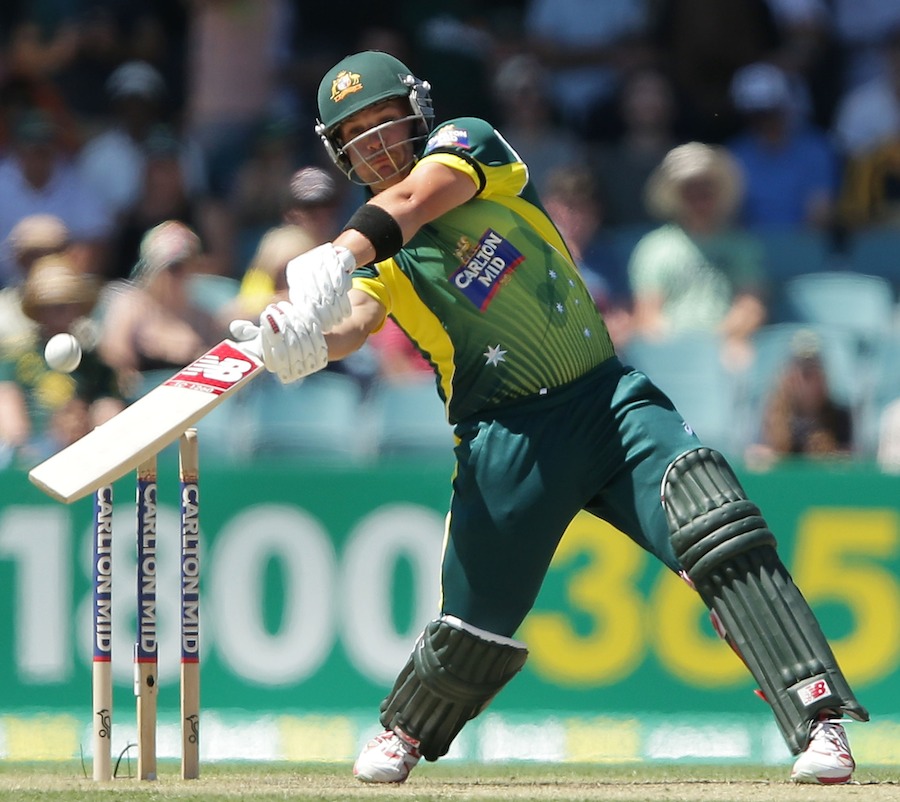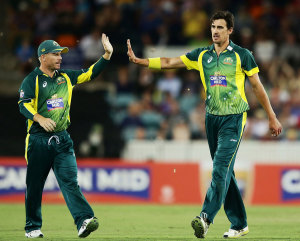Centurion Aaron Finch, Steven Smith, Josh Hazlewood and Mitchell Starc were central figures in Australia’s commanding 73-run victory over South Africa in Canberra, despite a pair of sparkling innings by Hashim Amla and AB de Villiers.
In front of a crowd of 10,583 at Manuka Oval, Finch set the platform and Smith capitalised fully upon it against a South African bowling attack that found less assistance than they enjoyed in Perth but also did not help their cause with a quartet of no-balls.
Dale Steyn was the lone exemplar of parsimony for the visitors, but even his 10 overs ultimately yielded 53 runs, and he was unable to take the wickets he had yearned for when describing a new attack role for himself on match eve.
A target of 330 was always going to be difficult for the visitors given Australia’s selection of a deep and varied bowling attack that in Starc and Hazlewood had relevant experience of Canberra climes. Hazlewood and Starc both bowled piercingly with the old ball, the latter gaining sharp reverse swing to bring a swift conclusion to the match. Six wickets went down for 32 following de Villiers’ exit, and last man Imran Tahir did not emerge due to a knee strain picked up while bowling.
For a while, the cultured Amla and impudent de Villiers seemed capable of threatening, but the otherwise expensive Kane Richardson struck the critical blow by pinning de Villiers lbw just when South Africa’s equation had started to become realistic.
Hazlewood found the right line and length to spread-eagle Amla’s stumps soon after, and Starc followed up with verve. Australia’s performance was the equal of anything they have produced in ODI matches over the past 12 months, indicating that the team is warming up nicely in a World Cup season – albeit minus their hamstrung captain Michael Clarke.
Having not passed 50 for state or country since the final of the ODI triangular series in Zimbabwe in September, some 13 innings ago, Finch played within himself to begin with, allowing Warner to make the swifter start while occasionally unleashing with shots such as his pulled six off Vernon Philander.
He would have been conscious of the selectors’ decision to drop Glenn Maxwell following his somewhat ordinary start to the home season, a highest score of 29 in four limited overs innings across the Twenty20 and ODI series. As T20 captain and Warner’s preferred ODI opening partner, Finch has enjoyed a stronger expression of faith from the national selector Rod Marsh and the coach Darren Lehmann.
Manuka’s warm weather and a pristine pitch allowed Finch to play the ball more or less where he wanted, and he gathered pace steadily through the innings. Unable to gain the desired economy from Tahir, de Villiers leaned on the modest offerings of Farheen Behardien and himself, with mixed results.
Behardien at least enjoyed the pleasure of dismissing Shane Watson once more, this time drawing a miscued pull shot to end an innings from Australia’s No. 3 batsman that, at 40 from 38 balls, looked ready to grow wings. De Villiers was more expensive, but was rewarded for attacking the stumps when Finch swung a little too zealously for the midwicket fence.
Smith batted busily as ever, running hard and picking gaps on the ground where his century as captain of New South Wales had secured the Blues’ Sheffield Shield title last summer. Morne Morkel added a final no-ball in the 50th over, and Smith flicked a jaunty boundary behind square leg from the resultant free hit.
Australia’s final tally was about 30 more than South Africa would have preferred to concede, and Hazlewood and Starc made sure it would prove far too many.
(Taken from ESPNcricinfo, by Daniel Brettig)



